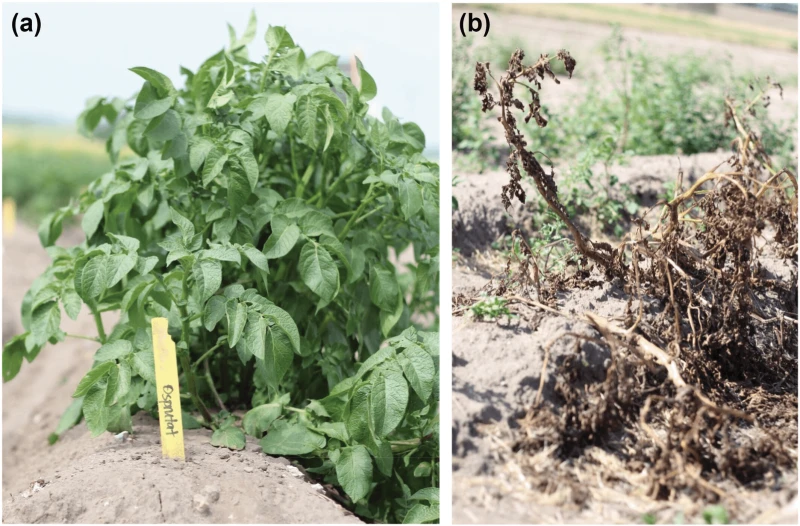How to reduce chemical usage? European study concludes GM and gene-edited crops are a solution, proposed relaxed EU regulations would limit innovation
How to reduce chemical usage? European study concludes GM and gene-edited crops are a solution, proposed relaxed EU regulations would limit innovation


Can modern breeding technologies, such as genome editing, contribute to reduced pesticide usage? This question has been accentuated by a recent legal proposal to exempt genome-edited plants from the strict regulations applied to classical genetically modified (GM) crops within the European Union (EU). Using official statistics on crop cultivation and pesticide usage for two example crops commonly grown in Sweden, we calculate that cereal farmers collectively could save up to 70 million € in pesticide usage for wheat alone and that a late blight-resistant potato could reduce pesticide usage by over 80% provided that the EU legislation is amended.
…
NGT plants can contribute to reduced pesticide usage but also that the required number of loci that need to be modified can be quite high, especially in polyploid species. In order to increase the longevity of—genes, the genes should be stacked, possibly combining three R-genes per pathogen. Hence, if we want to make a potato resistant against the major diseases outlined above, we would need to introduce at least nine modifications
It should be noted that there are no technical limitations to the number of modifications that can be induced in a crop, and efficient methods have been developed to induce multiple mutations using one CRISPR/Cas9 construct….
…
However, the EC recommends a maximum of 20 targeted mutations for category 1 NGT plants. This limit may pose a challenge for polyploid crops, such as crops like wheat or potato….
…
The NGT legislative proposal holds the promise to facilitate the implementation of NGT crops in European agriculture. However, several technical limitations in the proposal will, if implemented, hamper that development. To account for differences in genome size and complexity among different plant species, we urge legislators to count the maximum number of allowed changes for a category 1 NGT plant per basic set of chromosomes, allowing for an increased number of modifications in polyploid species.
This is an excerpt. Read the original post here

 | Videos | More... |

Video: Nuclear energy will destroy us? Global warming is an existential threat? Chemicals are massacring bees? Donate to the Green Industrial Complex!
 | Bees & Pollinators | More... |

GLP podcast: Science journalism is a mess. Here’s how to fix it

Mosquito massacre: Can we safely tackle malaria with a CRISPR gene drive?

Are we facing an ‘Insect Apocalypse’ caused by ‘intensive, industrial’ farming and agricultural chemicals? The media say yes; Science says ‘no’
 | Infographics | More... |

Infographic: Global regulatory and health research agencies on whether glyphosate causes cancer
 | GMO FAQs | More... |

Why is there controversy over GMO foods but not GMO drugs?

How are GMOs labeled around the world?

How does genetic engineering differ from conventional breeding?
 | GLP Profiles | More... |

Alex Jones: Right-wing conspiracy theorist stokes fear of GMOs, pesticides to sell ‘health supplements’




 Viewpoint — Fact checking MAHA mythmakers: How wellness influencers and RFK, Jr. undermine American science and health
Viewpoint — Fact checking MAHA mythmakers: How wellness influencers and RFK, Jr. undermine American science and health Viewpoint: Video — Big Solar is gobbling up productive agricultural land and hurting farmers yet providing little energy or sustainabilty gains
Viewpoint: Video — Big Solar is gobbling up productive agricultural land and hurting farmers yet providing little energy or sustainabilty gains Fighting deforestation with CO2: Biotechnology breakthrough creates sustainable palm oil alternative for cosmetics
Fighting deforestation with CO2: Biotechnology breakthrough creates sustainable palm oil alternative for cosmetics Trust issues: What happens when therapists use ChatGPT?
Trust issues: What happens when therapists use ChatGPT? 30-year-old tomato line shows genetic resistance to devastating virus
30-year-old tomato line shows genetic resistance to devastating virus California, Washington, Oregon forge immunization alliance to safeguard vaccine access against federal undermining
California, Washington, Oregon forge immunization alliance to safeguard vaccine access against federal undermining The free-range chicken dilemma: Better for birds, but with substantial costs
The free-range chicken dilemma: Better for birds, but with substantial costs ‘You have to treat the brain first’: Rethinking chronic pain with Sanjay Gupta
‘You have to treat the brain first’: Rethinking chronic pain with Sanjay Gupta
